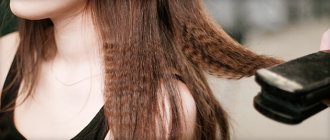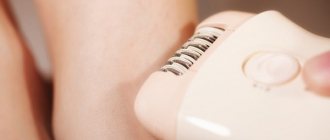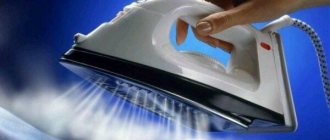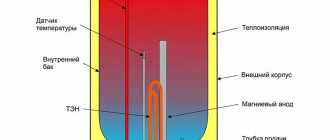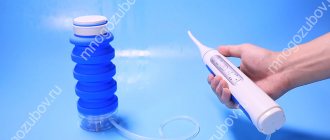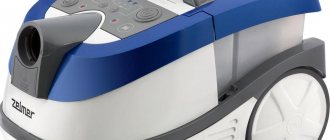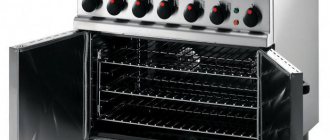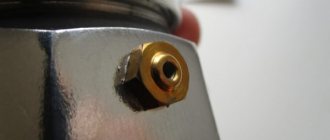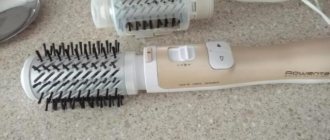What is this procedure
To carry out home photoepilation, you will need to purchase a special device - a photoepilator. It is selected individually, based on the characteristics of the skin and hair.
Human hair consists of:
- follicle;
- root;
- rod.
They contain a special substance – melanin, which gives hair its color. The operating principle of the photoepilator is based on its ability to absorb light radiation and accumulate it in the bulb in the form of thermal energy. Under its influence, the hair structure is subsequently destroyed.
The intensity of light energy absorption depends on the melanin content in the hair - the more there is, the sooner it will be possible to remove unwanted hair. Coarse dark hair is removed most quickly, and it is completely impossible to remove gray, fluff and light hair using photoepilation.
Pay attention to this when choosing a photoepilator. It must emit a specific wavelength of light that will be most effectively absorbed by melanin. This selective effect is called selective (selective) hair removal.
Hair heating temperature
Photoepilators used in cosmetology heat the hair up to 800 C. Because of this, all the cells of the hair bulb (follicle) die, so its growth does not resume. When using a device of lower intensity, destruction of follicle tissue also occurs, but to a low degree.
Depilation using this method is effective when treating hair in the active growth phase. Since they appear on the surface of the body at different times, several sessions will be required for the skin to become completely smooth. Usually 5-12 procedures are enough; the exact number of trips to the salon can only be determined by a cosmetologist.
Using photoepilation, you can remove hair from almost any part of the body (except for the cases listed in the contraindications):
- armpit area;
- upper and lower limbs;
- bikini;
- stomach.
Only an experienced specialist can tell you how to do photoepilation correctly and effectively at home, so it is advisable to consult with him before the procedure.
Advantages and disadvantages
All cosmetic procedures for removing unwanted hair have pros and cons relative to each other. Hair removal using a photoepilator is no exception; it has the following advantages:
- the epidermis is not damaged, which reduces the risk of infection;
- After the manipulation there are no ingrown hairs - the follicles are completely destroyed.
Due to the fact that some of the hair follicles in the skin are in “sleep mode,” it is impossible to completely get rid of hair in one procedure. But visible results will be noticeable immediately after the first use.
Some of the positive side effects of light energy on the skin include:
- rejuvenation;
- smoothing out small wrinkles;
- healthy and fit appearance.
Before going for photoepilation, you should remember that it has the following disadvantages:
- It will take several sessions, so you need to have patience and money (if done in a beauty salon).
- It is not suitable for sensitive skin.
- Home hair removal involves the use of devices with low power, so complete removal of unwanted hair in one go is impossible.
- Facial hair growth in women is usually a consequence of hormonal imbalance. When epilating this area, it should be taken into account that it will not be possible to completely get rid of vegetation on it. It is also not recommended to irradiate it often - the skin there is thin and delicate, otherwise it will lead to sad consequences.
- It is ineffective in the fight against gray, weakened and melanin-deprived vegetation.
- With a low pain threshold, severe discomfort appears. Therefore, before doing photoepilation, you need to test the device on one area of the body.
Another disadvantage of the procedure is the ability of light radiation to degenerate some types of papillomas and moles into malignant neoplasms.
Is the device suitable for hair removal?
It is quite simple to check whether a photoepilator is suitable for a representative of the fair sex.
The procedure is effective if a woman has dark hair and light skin. The stronger the contrast between hair and skin, the more noticeable the result will be.
After all, the light flash of a Philips photoepilator is aimed at absorbing melanin, the pigment that is responsible for the dark shade of hair. Therefore, this method of getting rid of excess hair on the body is not suitable for owners of blond, gray and red hair.
Women with dark skin are also advised not to purchase a photoepilator. The fact is that tanned skin contains melanin. As a result, using a photoepilator can cause severe burns.
Side effects
Destruction of hair follicles during photoepilation occurs due to exposure to thermal energy. Therefore, with high skin sensitivity, the risk of burns increases. Most often it appears due to incorrect selection of light intensity or equipment malfunction. If the device is working properly, a burn may occur due to depilation at the wrong time: after prolonged exposure to the sun or during irritation.
Before doing photoepilation on large areas of the body, you should observe how the skin behaves after it. An allergic reaction to light flashes or post-epilation care products is possible.
When working with a photoepilator, you must take care of protecting your eyesight - light flashes impair vision.
How to choose a device
Photoepilators for home use are sold in consumer electronics stores. They are relatively inexpensive, but have a small range of light emission and, accordingly, have low efficiency. Before purchasing a device for personal use, you should weigh the pros and cons of photoepilation. To familiarize yourself with the procedure, it is recommended to conduct a trial hair removal session in a cosmetology office with a specialist.
When purchasing a photoepilator, pay attention to the following characteristics of the device:
- Power (selected based on the characteristics of the hair: thickness, color intensity). The correct value of this value for home use devices is from 3 to 5 J per 1 cm2.
- Area covered. The time it takes for the procedure depends on its value. Devices with a reading of up to 6 cm2 are suitable for hair removal at home.
- Flash speed. It should be about 2 seconds.
- Lamp quality. The higher it is, the longer the device will last without replacing the light emitter.
If you plan to use the photoepilator at home yourself, then you need to pay attention to the presence of a special UV filter. It will protect your skin and vision from the negative effects of light flashes.
In addition to the photoepilator itself and protective glasses, you will need to purchase a cooling gel and an antiseptic to disinfect the epilated areas.
How to choose a Philips photoepilator
The quality of the device depends on its design, functionality and some other factors. However, in order to entrust such a delicate procedure as hair removal to a device, you need to choose it correctly. Therefore, we recommend that you pay attention to the following points.
By area of application
As mentioned earlier, there are household and professional models. If you need to monitor hair on delicate areas of the skin, it will be enough to acquire a small device without an additional range of modes. To eliminate bruises and age spots on the surface of the skin, it is better to use a professional gadget. A high-quality photoepilator can completely replace the most successful branded razor.
By way of nutrition
UV epilators can operate both from mains power and from rechargeable batteries. The type of power supply depends on the specific device model. If you choose a device with an independent power source, it will be convenient to use it while sitting in a chair or on a chair. Electrically dependent models require the procedure to be carried out near an outlet, but operating from the mains increases the power of the light flash. Philips devices do not require the purchase of special consumables.
According to functional qualities
Thanks to the additional kit, it becomes possible to remove hair from large areas of the skin. Don't forget about the useful "Slide and Flash" option. It represents a continuous delicate treatment of hairs. The advantage of such a program is that during treatment all defects on the skin will be completely eliminated. A feature such as “Child Lock” will be very useful if you have to store the device in the bottom drawer of the cosmetic table.
It is not recommended to use a photoepilator for tanned skin.
Number of flashes and replacement of work lamps
The number of light flashes affects the operating mode of the built-in lamps that create this radiation flux. The optimal rate is up to 150 thousand flashes with the ability to replace the lamp. However, for Philips epilators, this factor can be neglected if you choose an expensive and functional model.
Flash is hazardous to your eyesight. Therefore, it is not recommended to point a working epilator at your face.
Carrying out hair removal
Detailed information on how to use the photoepilator correctly and how to properly do photoepilation at home can be found in the device’s instruction manual. For additional information, it is advisable to contact a specialist - a certified cosmetologist who has experience working with such equipment. He will tell you how to do photoepilation at home so that all the negative aspects of it are minimized.
One of the main rules of photoepilation is regular sessions. How often you will need to use an epilator depends on the model of the device, its power and the individual characteristics of the body.
When testing a new device, it is enough to epilate a small area of skin in an easily accessible area - the armpits or lower legs. You should start with 1-2 flashes, setting the intensity of the emitter to a medium value. If there is no discomfort, then add power according to the instructions. During the trial procedure, do not lean the device too often - you can get burned.
It should be remembered that if there is no pain at all, then the power of the device is not suitable and there will be no effect from it. There should also be no pain that is too severe.
Skin care after photoepilation
After each procedure, you should carefully monitor your skin. Immediately after the procedure, you usually need to apply a special cream with a calming effect. For a certain period of time (up to two weeks) you should refrain from tanning. Immediately after the procedure, do not take a hot bath or go to the sauna.
In any case, there may be some individual characteristics that force you to deviate somewhat from the established norms. But, given that the procedure is lengthy, about 10 sessions are needed for complete hair removal, it is better to comply with all conditions. Otherwise, illiterate hair removal will not have an effect, and your efforts will be useless for a long time.
See also:
- 5 Best Rowenta Epilators of 2021
- 9 best Philips epilators of 2021
- 10 best epilators for women according to customer reviews
- 10 best photoepilators according to user reviews
- 11 Best Braun Epilators of 2021
Preparation
In order for the procedure to be successful, the skin is first prepared - a light peeling is done on the area to be epilated. If you don’t have special products at hand, a massage with honey or tomato puree will do. Hair that is too long is shaved off with a machine - its length should not exceed 2-4 mm.
Before starting the session, the working device is wiped with lint-free wipes - it must be clean from dust and free of streaks. Next comes a check for serviceability - almost all models of home photoepilators have a touch sensor. If the device is applied correctly, it will begin to emit a sound or light signal. After the flash, it repeats, notifying that the manipulation was successful.
The photoepilator is moved along a horizontal line so that flashes of light do not affect the same area several times. This will help avoid burns. When depilating a large area, you can switch to the sliding mode.
You should follow the instructions for using the photoepilator - some models require applying a protective gel to the skin during use. This will help make the procedure more comfortable and safer.
The time spent on one session depends on the condition of the hair. Basically, photoepilation at home, if you have the skill, takes a little time:
- legs – from 8-20 minutes;
- bikini area – 5-10 minutes;
- deep bikini – 20 minutes;
- armpits – 2-8 minutes.
When not to do photoepilation
Contraindications include:
- pregnancy, breastfeeding;
- pathologies of the cardiovascular and chronic diseases of the endocrine system;
- damage to the skin: burns, abrasions, cuts;
- You cannot remove hairs growing from a nevus - there is a risk of thermal burn;
- age up to 14 years.
Photoepilation is a low-traumatic method of removing unwanted hair, but it should be carried out with caution, carefully weighing the advantages and disadvantages. It is important to maintain a pause of several weeks between sessions - this will help reduce the negative effects of light radiation on unprotected skin.
Skin care after the procedure
During photoepilation, the skin is minimally exposed to heat. After this, soothing creams or gels are applied to the epilated area. They help avoid irritation and redness. To prevent damage to the skin, it is recommended to avoid saunas, baths and prolonged exposure to the sun for several days.
When performing photoepilation at home, you should pay attention to the sensations - there should not be any significant discomfort. Otherwise, it is better to choose other methods of body hair removal.
How the Philips Lumea BRI863 photoepilator works
All women, without exception, dream of thick and voluminous hair on their heads, but they try to get rid of unwanted “vegetation” on the skin in every possible way. However, some of them are too painful, while others do not give the desired result. But all these shortcomings can be forgotten thanks to the appearance of the Philips Lumea Essential photoepilator. Reviews of this device confirm its high effectiveness in combating hair growth on the skin. What makes it unique?
The photoepilator is based on the technology of intense pulses of light (IPL). The company's specialists managed to apply an effective method of preventing hair growth, used in specialized salons, when inventing a device designed for hair removal at home. IPL technology involves treating the skin with pulses of light. They are absorbed by the hair root and force the follicle to enter the resting phase. Due to this, existing hair on the skin falls out, and the growth of new ones stops.
The photoepilator has a compact size. The body of the device is made of high-quality white plastic. At the top there is a glass ultraviolet filter. In addition, there is a skin tone sensor, indicators of intensity and readiness to send an impulse.
